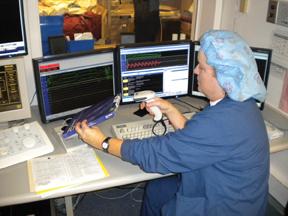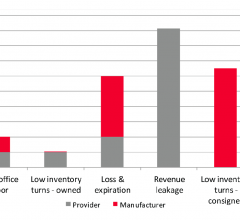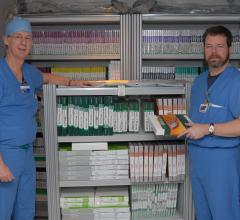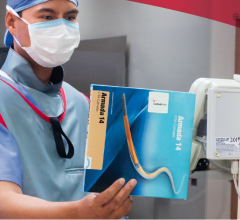
The inventory management screen for the Wavemark RFIC cabinet system.
There are many avenues for the improvement of cath lab inventory control to become more efficient with the emphasis being not faster, but smarter, avoiding waste, and without jeopardizing patient safety. Many different methods are now available to assist in managing inventory. Advances in computer technology, such as radio-frequency identification (RFID) and bar-coding, enable cath lab staff to track what’s on the shelf in the rooms, what’s on hand in the department overall in the form of par levels, and what’s on back order. If one is truly on the ball they should also be completely aware of any product about to expire.
WaveMark says its RFID tag sensing storage cabinets automatically track items so hospitals can eliminate waste, reduce inventory levels, optimize bulk buys, improve charge capture, immediately identify the location and number of recalled products automatically by lot and serial number. The company says the system allows staff to spend more time with patients and less time searching stockroom shelves.(1)
One could debate the best way is to be fully computerized by using RFID systems, which track the product from the time it’s stocked in a cabinet or removed during a procedure. This eliminates the “old fashioned” manual method where the RN’s or technologists track and document by hand what is used in the procedure, charged to the patient, reordered and replaced. The latter method requires closer control, physically counting the items daily, and checking expiration dates and rotating stock from busier interventional rooms to those used less frequently. Depending on the logistics of your department and amount of available space, the answer to the best system lies somewhere in between a totally computerized system and manually recorded records.
The GE MacLab Hemodynamic monitoring system tracks usage as the case progresses by scanning items used, automatically populating the event log. Custom reports can be generated at the end of the case showing all items used along with CPT and charges codes for billing. By generating monthly reports, one can match what was purchased to what was used and billed. Any discrepancies can be examined, identified and resolved. According to GE “MacLab provides comprehensive inventory reports helping automate key administrative responsibilities, such as tracking inventory item usage by vendor and physician, maintaining in-stock value of consignment verses nonconsignment items, and providing notification of items with upcoming expirations.”(2) On a monthly basis I’m sure every manager has been asked by the finance department, for “reasons for variance,” the typical questions of why your supply costs do not go down if your patient volume goes down. Typically this is due to the complexity of the case and the acuity of the patient. By providing accurate reports one can track, show and compare interventions where the cost per case may be $4,000 for a stent procedure, where another may be $23,000. For example, in the first case two stents, one guide catheter, one wire and two balloons may have been used, but the second case used 12 guide catheters, eight wires, four balloons, six stents and IABP.
Managers should have the tools to track usage, monitor par levels and expiration dates, with the emphasis being on reducing waste, tracking and charging for everything used, because reducing missed charges equate to reduction in revenue. Check for any vendor indigent patient programs where the cost of the stent, balloon or wire is reimbursed to the hospital for unfunded patients.
Expiration dates are a two-pronged risk. Firstly, on a regulatory and compliance basis they cannot and should not be implanted if the product has expired. Secondly, if the hospital has purchased the product, responsibility lies with the manager to replace it at hospital cost. Vendors may guarantee to replace expired items at their cost, and for this reason, in an ideal world, the cath lab should have at least 80 percent of all interventional products on consignment. If the product is on consignment it technically belongs to the vendor, therefore the vendor is liable to check expiration dates and rotate stock to prevent revenue loss.
The cath lab staff is responsible in preventing expired products from reaching the patient from a quality/regulatory/compliance risk. As a proactive measure, cath labs should be using team resource management (TRM) type cross checks, as used in the airline industry. The physician asks for a 3 x 20 mm Xience, the circulator should verbally repeat the request “3 x 20 mm Xience.” The physician or scrub tech should acknowledge and confirm “correct.” The circulator should then remove product from shelf, check type, size and expiration date of product and then verbally state “I have 3 x 20 mm Xience,” prior to opening sterile package. The scrub tech or physician should confirm verbally for the last time “correct.” By following these steps as in administering medications, the risk of implanting wrong stent, wrong size, is reduced or eliminated. From an inventory control point of view this also prevents loss of revenue if the wrong stent is opened and not implanted. Most vendors have a no-cross guarantee, meaning they will replace the stent if the physician is unable to cross the lesion and a competitor’s stent does.
Control of inventory in your cath lab is directly relevant to your revenue cycle. One has to track what was purchased, what was charged for, constantly monitor and adjust par levels in accordance with what’s being used, especially physician preference items, where perhaps one product is used less because a physician is on vacation. With oversight of your revenue cycle, one should be able to keep a finger on the pulse, maintain zero waste, 100 percent compliance with billing reconciliation, and zero risks from expired products. Computer software programs can assist and monthly reports can be set up and printed, but at the end of the day you must rely on your inventory manager to oversee items on a daily basis to track par levels, back orders, and new products.
Some physicians request specific products only they will use. For this reason inventory managers should develop a good working relationship with their physicians, who should have buy in to the responsibility of managing the cath lab inventory budget. The cath lab manager’s relationship with physicians should be collaborative, one should be able to approach physicians and ask if they can use a different stent, wire, or guide catheter. The cath lab may have a competitive product that is less expensive, or perhaps be on contract with your GPO.
At least monthly, inventory managers should meet with their busiest physicians to explain their needs and to ask the physicians what they need. Managers should also explain budget variances to them and ask for their support.
With Crystal reports from Mac Lab, another valuable report that can be generated is cost per case, per physician. Using this report, managers can tune in to high-dollar cases to see why they are different or cost more than others. Is it due to technique, patient acuity, or vendor preference? The Mac Lab is a wonderful tool as long as used appropriately. Like any other system, the saying is “garbage in, garbage out.” If your staff does not enter products accurately, don’t expect to see accurate report data. In order to assure this, cath lab staff must carry out case event log audits. My staff does this on every case. When we have any down time they audit each other’s event logs to cross check for accuracy of recording supplies, proper charge codes, in addition to pressure waveform recordings, pull backs and any snapshots. All information gleaned is used to train others in addition to teaching any new hires the “right way.”
Colin Ramsey manages cardiac services at Sharp Grossmont Hospital in La Mesa Calif. and is a member of Diagnostic and Invasive Cardiology’s Editorial Board.
References
1. GE Healthcare Centricity Cardiology Inventory Management Module. (n.d.). Retrieved June 5, 2009, from www.gehealthcare.com/usen/cath_ep_labmon/docs/Centricity%20Cardiology%20DMS%20Inventory%20Management.pdf
2. WaveMark; New Level of Patient Safety Achieved through Integration of RFID and Recall Management Service for Hospitals. (2009, March). Biotech Business Week, 2098. Retrieved June 3, 2009, from ProQuest Health and Medical Complete Database. (Document ID: 1666713311).




 April 28, 2017
April 28, 2017 









